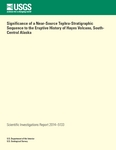Hayes Tephra A
Start: 4450 yBP ± 30 Years [1]
Stop: 3690 yBP ± 30 Years [1]
Event Type: Explosive
- Tephrafall [1]
Description: From Wallace and others (2015): "Tephra A respresents an eruption of rhyolitic and dacitic magma as recent as 4,450+/-30 14C yr B.P. The rhyolite component of tephra A is compositionally and mineralogically distinct from the younger dacite tephras. It should be possible to recognize and correlate distal equivalents to tephra A by the absence of amphibole and pyroxene, and an abundance of small biotite grains and quartz in the rhyolite fraction of the deposit. Tephra A magnetites have unusually low MgO and Al2O3and high MnO, which may also be useful for recognizing distal equivalents."
"Tephra A (AT-2558) is oxidized, which imparts a moderate brown color to the deposit (fig. 6 [in original text]). Tephra A contains two compositions of pumice, a bright white low-silica rhyolite (72.8 weight percent SiO2 whole-rock composition; all SiO2concentrations reported for analyses recalculated to sum to 100 weight percent volatile-free) with high-silica rhyolite matrix glass (76.5 weight percent SiO2) and a creamy white dacite with rhyolite matrix glass (70.8 and 72.4 weight percent SiO2) (tables 4, 5 [in original text]). The sample is dominantly composed of pumice grains (rather than glass shards) and free crystals. Pumices are generally inflated and glassy. Rhyolite lapilli contain feldspar and quartz in a glassy groundmass with biotite microlites and aligned vesicles (fig. 7E [in original text]). Plagioclase and amphibole are the dominant phenocrysts phases in dacite lapilli (fig. 7F [in original text]). Proportions of the two lapilli types are unknown. Rare biotite (<1 percent) is observed in all size fractions. Mafic mineral point counts suggest a high amphibole to pyroxene ratio (table 3, fig. 8 [in original text]). In general, mafic minerals as free crystals are rare compared to pumice grains and felsic crystals. Glass in both lapilli types was easy to analyze by electron microprobe owing to the relatively large areas between vesicles."
"Tephra A (AT-2558) is oxidized, which imparts a moderate brown color to the deposit (fig. 6 [in original text]). Tephra A contains two compositions of pumice, a bright white low-silica rhyolite (72.8 weight percent SiO2 whole-rock composition; all SiO2concentrations reported for analyses recalculated to sum to 100 weight percent volatile-free) with high-silica rhyolite matrix glass (76.5 weight percent SiO2) and a creamy white dacite with rhyolite matrix glass (70.8 and 72.4 weight percent SiO2) (tables 4, 5 [in original text]). The sample is dominantly composed of pumice grains (rather than glass shards) and free crystals. Pumices are generally inflated and glassy. Rhyolite lapilli contain feldspar and quartz in a glassy groundmass with biotite microlites and aligned vesicles (fig. 7E [in original text]). Plagioclase and amphibole are the dominant phenocrysts phases in dacite lapilli (fig. 7F [in original text]). Proportions of the two lapilli types are unknown. Rare biotite (<1 percent) is observed in all size fractions. Mafic mineral point counts suggest a high amphibole to pyroxene ratio (table 3, fig. 8 [in original text]). In general, mafic minerals as free crystals are rare compared to pumice grains and felsic crystals. Glass in both lapilli types was easy to analyze by electron microprobe owing to the relatively large areas between vesicles."
References Cited
[1] Significance of a near-source tephra-stratigraphic sequence to the eruptive history of Hayes Volcano, south-central Alaska, 2014
Wallace, K.L., Coombs, M.L., Hayden, L.A., and Waythomas, C.F., 2014, Significance of a near-source tephra-stratigraphic sequence to the eruptive history of Hayes Volcano, south-central Alaska: U.S. Geological Survey Scientific Investigations Report 2014-5133, 32 p., available online at: http://pubs.usgs.gov/sir/2014/5133/Complete Eruption References
Significance of a near-source tephra-stratigraphic sequence to the eruptive history of Hayes Volcano, south-central Alaska, 2014
Wallace, K.L., Coombs, M.L., Hayden, L.A., and Waythomas, C.F., 2014, Significance of a near-source tephra-stratigraphic sequence to the eruptive history of Hayes Volcano, south-central Alaska: U.S. Geological Survey Scientific Investigations Report 2014-5133, 32 p., available online at: http://pubs.usgs.gov/sir/2014/5133/
